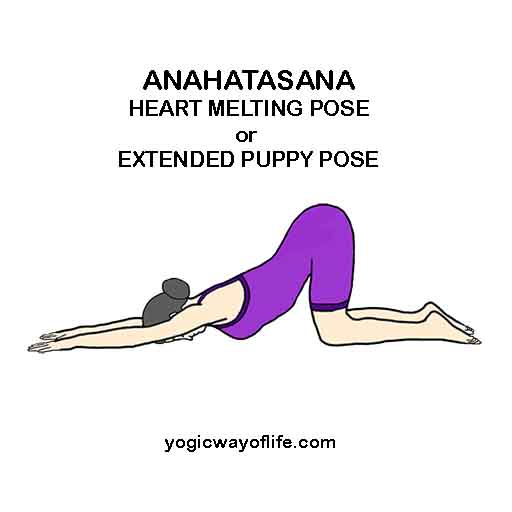Anahatasana or the heart melting pose is soothing to the heart. In Sanskrit, Anahata means the heart and Asana means a pose. It is also known as the half-dog pose and opens up the shoulders. It stimulates the heart center or the Anahata chakra.

How to do Anahatasana (Heart Melting Pose)?
- Start with the kneeling position or Vajrasana, sitting with hands on the thighs.
- Exhale and bend forward touching the head to the ground. Slide the hands on the floor in front of you. Move the hands above the head with the palms facing downwards and touching the floor. The entire forearm can be in contact with the floor for support.
- Raise the hips, while slightly arching the back backwards. Try to keep the thighs at 90 degrees to the lower leg as much as possible. This will create a nice arch of spine.
- Let the forehead touch the ground.
- The upper chest can rest on the floor if possible but it is not essential. Do not strain. Remain in your comfort zone while performing asanas.
- Breathe normally and slowly in this final position. Remain in this position for as long as you are comfortable.
- To release the position, slide the hands back and come to the child’s pose or Balasana by lowering the hips. You can remain in Balasana, which is a good resting pose for few moments. Come back to the kneeling position and take few slow deep breaths.
Benefits of Anahatasana (Heart Melting Pose)
- Anahatasana expand the chest and give a soothing effect on the Anahata Anahata chakra is associated with feelings and emotions. It can release some our blocked emotions and we can feel free of the burdens of the heart.
- It releases the tensions and creates a sense of well-being in the mind.
- It opens up the chest and is good for respiratory function.
- It can make the spine flexible and improves posture.
- Upper back and the lower back gets a gentle stretch.
- Anahatasana also helps to open up the shoulders.
Contraindications for Anahatasana
- Those suffering from any neck, shoulder or knee injury should not do Anahatasana.
- Those who had any of recent surgery of the back, thighs or knees should avoid this asana.
- If you have severe knee pain, do not do this pose.
- Practice this pose preferably on an empty stomach as much as possible. Avoid it after a heavy meal.
